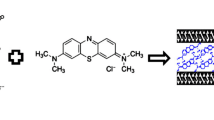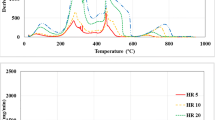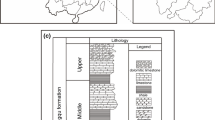Abstract
This study aimed to evaluate the practical usefulness of kinetic deconvolution analysis (kDa) as a means to obtain the kinetic information on specific reaction steps that characterize the thermal properties of materials for various purposes. The partially overlapping multistep thermal decomposition of Maya Blue (MB)-type pigments was used as an example reaction. Red and yellow MB-type pigment materials, composed of a fibrous clay mineral and an organic dye, were synthesized using palygorskite and sepiolite as the clay minerals and Methyl Red and Alizarin as red and yellow dyes, respectively. The multistep thermal decompositions of the MB-type pigments were investigated using thermogravimetry. The thermoanalytical data were deconvoluted into individual component reaction steps using an empirical kDa technique based on a cumulative kinetic equation that considers the contribution of each reaction step to the overall thermal decomposition. By comparing the kDa results for the thermal decomposition of the composites with those for the decomposition of pure palygorskite and sepiolite, the thermal decomposition steps for the incorporated organic dyes were extracted from the multistep thermal decompositions of the MB-type pigments. Finally, the thermal stabilities of MB-type pigments comprising different clay minerals and organic dyes were compared using the kinetic results extracted for the reaction step associated with the decomposition of the organic dyes.












Similar content being viewed by others
References
Chen M, Li X, Wang Y, Wang C, Liang T, Zhang H, et al. Hydrogen generation by steam reforming of tar model compounds using lanthanum modified Ni/sepiolite catalysts. Energy Convers Manag. 2019;184:315–26. https://doi.org/10.1016/j.enconman.2019.01.066.
Chen M, Wang C, Wang Y, Tang Z, Yang Z, Zhang H, et al. Hydrogen production from ethanol steam reforming: effect of Ce content on catalytic performance of Co/Sepiolite catalyst. Fuel. 2019;247:344–55. https://doi.org/10.1016/j.fuel.2019.03.059.
Chuaicham C, Pawar R, Sasaki K. Dye-sensitized photocatalyst of sepiolite for organic dye degradation. Catalysts. 2019. https://doi.org/10.3390/catal9030235.
Guerrero-Torres A, Jiménez-Gómez CP, Cecilia JA, García-Sancho C, Franco F, Quirante-Sánchez JJ, et al. Ni supported on sepiolite catalysts for the hydrogenation of furfural to value-added chemicals: influence of the synthesis method on the catalytic performance. Top Catal. 2019;62(5–6):535–50. https://doi.org/10.1007/s11244-019-01168-z.
Huang C, Wang Y, Gong M, Wang W, Mu Y, Hu Z-H. α-MnO2/palygorskite composite as an effective catalyst for heterogeneous activation of peroxymonosulfate (PMS) for the degradation of Rhodamine B. Sep Purif Technol. 2020. https://doi.org/10.1016/j.seppur.2019.115877.
Kuang M, Zhang J, Wang W, Chen J, Cao Y, Liu R, et al. The effect of support on the structure and photocatalytic activity of ternary ZnO–ZnFe2O4/palygorskite composite photocatalysts. Adv Powder Technol. 2019. https://doi.org/10.1016/j.apt.2019.08.030.
Lakbita O, Rhouta B, Maury F, Senocq F, Amjoud M, Daoudi L. On the key role of the surface of palygorskite nanofibers in the stabilization of hexagonal metastable β-Ag2CO3 phase in palygorskite-based nanocomposites. Appl Clay Sci. 2019;172:123–34. https://doi.org/10.1016/j.clay.2019.02.023.
Luo T, Wang M, Tian X, Nie Y, Yang C, Lin HM, et al. Safe and efficient degradation of metronidazole using highly dispersed β-FeOOH on palygorskite as heterogeneous Fenton-like activator of hydrogen peroxide. Chemosphere. 2019;236:124367. https://doi.org/10.1016/j.chemosphere.2019.124367.
Luo Y, Zhang M, Yin H, Yao J, Chen S-M, Liu X. One pot controllable synthesis of palygorskite/bismuth oxyiodide hierarchical microspheres for improved visible-light photocatalytic performance. Colloids Surf A. 2019. https://doi.org/10.1016/j.colsurfa.2019.06.038.
Lycourghiotis S, Kordouli E, Sygellou L, Bourikas K, Kordulis C. Nickel catalysts supported on palygorskite for transformation of waste cooking oils into green diesel. Appl Catal B. 2019. https://doi.org/10.1016/j.apcatb.2019.118059.
Ouyang J, Zhao Z, Suib SL, Yang H. Degradation of congo red dye by a Fe2O3@CeO2–ZrO2/palygorskite composite catalyst: synergetic effects of Fe2O3. J Colloid Interface Sci. 2019;539:135–45. https://doi.org/10.1016/j.jcis.2018.12.052.
Xie A, Tang Y, Huang X, Jin X, Gu P, Luo S, et al. Three-dimensional nanoflower MnCrO/Sepiolite catalyst with increased SO2 resistance for NH3-SCR at low temperature. Chem Eng J. 2019;370:897–905. https://doi.org/10.1016/j.cej.2019.03.226.
Shi T, Li S, Zhang H, Li Z, Zhu M. Preparation of palygorskite-based phase change composites for thermal energy storage and their applications in Trombe walls. J Wuhan Univ Mater Sci Ed. 2017;32(6):1306–17. https://doi.org/10.1007/s11595-017-1746-z.
Zhang Y, Yu C, Hu P, Tong W, Lv F, Chu PK, et al. Mechanical and thermal properties of palygorskite poly(butylene succinate) nanocomposite. Appl Clay Sci. 2016;119:96–102. https://doi.org/10.1016/j.clay.2015.07.022.
Yang D, Peng F, Zhang H, Guo H, Xiong L, Wang C, et al. Preparation of palygorskite paraffin nanocomposite suitable for thermal energy storage. Appl Clay Sci. 2016;126:190–6. https://doi.org/10.1016/j.clay.2016.03.014.
Liu Y, Han S, Jiang Y, Liang J, Shang R, Hao B, et al. Poly(lactic acid)/palygorskite nanocomposites: enhanced the physical and thermal properties. Polym Compos. 2017;38(8):1600–8. https://doi.org/10.1002/pc.23727.
Yang D, Shi S, Xiong L, Guo H, Zhang H, Chen X, et al. Paraffin/Palygorskite composite phase change materials for thermal energy storage. Sol Energy Mater Sol Cells. 2016;144:228–34. https://doi.org/10.1016/j.solmat.2015.09.002.
Konuklu Y, Ersoy O. Preparation and characterization of sepiolite-based phase change material nanocomposites for thermal energy storage. Appl Therm Eng. 2016;107:575–82. https://doi.org/10.1016/j.applthermaleng.2016.07.012.
Herrero M, Asensio M, Núñez K, Merino JC, Pastor JM. Morphological, thermal, and mechanical behavior of polyamide11/sepiolite bio-nanocomposites prepared by melt compounding and in situ polymerization. Polym Compos. 2019;40(S1):E704–13. https://doi.org/10.1002/pc.24962.
Cui W, Zhang H, Xia Y, Zou Y, Xiang C, Chu H, et al. Preparation and thermophysical properties of a novel form-stable CaCl2·6H2O/sepiolite composite phase change material for latent heat storage. J Therm Anal Calorim. 2017;131(1):57–63. https://doi.org/10.1007/s10973-017-6170-2.
Shen Q, Liu S, Ouyang J, Yang H. Sepiolite supported stearic acid composites for thermal energy storage. RSC Adv. 2016;6(113):112493–501. https://doi.org/10.1039/c6ra22015k.
Polette-Niewold LA, Manciu FS, Torres B, Alvarado M Jr, Chianelli RR. Organic/inorganic complex pigments: ancient colors Maya Blue. J Inorg Biochem. 2007;101(11–12):1958–73. https://doi.org/10.1016/j.jinorgbio.2007.07.009.
Chiari G, Giustetto R, Druzik J, Doehne E, Ricchiardi G. Pre-columbian nanotechnology: reconciling the mysteries of the Maya Blue pigment. Appl Phys A. 2007;90(1):3–7. https://doi.org/10.1007/s00339-007-4287-z.
Giustetto R, Seenivasan K, Bordiga S. Spectroscopic characterization of a sepiolite-based Maya Blue pigment. Period Mineral. 2010;79:21–37. https://doi.org/10.2451/2010pm0019.
Ovarlez S, Giulieri F, Delamare F, Sbirrazzuoli N, Chaze A-M. Indigo–sepiolite nanohybrids: temperature-dependent synthesis of two complexes and comparison with indigo–palygorskite systems. Microporous Mesoporous Mater. 2011;142(1):371–80. https://doi.org/10.1016/j.micromeso.2010.12.025.
Hubbard B, Kuang W, Moser A, Facey GA, Detellier C. Structural study of Maya Blue: textural, thermal and solidstate multinuclear magnetic resonance characterization of the palygorskite-indigo and sepiolite-indigo adducts. Clays Clay Miner. 2003;51(3):318–26. https://doi.org/10.1346/ccmn.2003.0510308.
Ovarlez S, Giulieri F, Chaze AM, Delamare F, Raya J, Hirschinger J. The incorporation of indigo molecules in sepiolite tunnels. Chem Eur J. 2009;15(42):11326–32. https://doi.org/10.1002/chem.200901482.
Yamamoto Y, Koga N. Thermal decomposition of Maya Blue: extraction of indigo thermal decomposition steps from a multistep heterogeneous reaction using a kinetic deconvolution analysis. Molecules. 2019;24(13):2515. https://doi.org/10.3390/molecules24132515.
Giustetto R, Seenivasan K, Bonino F, Ricchiardi G, Bordiga S, Chierotti MR, et al. Host/guest interactions in a sepiolite-based Maya Blue pigment: a spectroscopic study. J Phys Chem C. 2011;115(34):16764–76. https://doi.org/10.1021/jp203270c.
Caliandro R, Toson V, Palin L, Conterosito E, Aceto M, Gianotti V, et al. New hints on the Maya Blue formation process by PCA-assisted in situ XRPD/PDF and optical spectroscopy. Chem Eur J. 2019;25(49):11503–11. https://doi.org/10.1002/chem.201901932.
Sánchez-Ochoa F, Cocoletzi GH, Canto G. Trapping and diffusion of organic dyes inside of palygorskite clay: the ancient Maya Blue pigment. Microporous Mesoporous Mater. 2017;249:111–7. https://doi.org/10.1016/j.micromeso.2017.04.060.
Post JE, Heaney PJ. Synchrotron powder X-ray diffraction study of the structure and dehydration behavior of palygorskite. Am Mineral. 2008;93(4):667–75. https://doi.org/10.2138/am.2008.2590.
Nagata H. On dehydration of bound water of sepiolite. Clays Clay Miner. 1974;22(3):285–93. https://doi.org/10.1346/ccmn.1974.0220310.
Giustetto R, Llabres IXFX, Ricchiardi G, Bordiga S, Damin A, Gobetto R, et al. Maya Blue: a computational and spectroscopic study. J Phys Chem B. 2005;109(41):19360–8. https://doi.org/10.1021/jp048587h.
Manciu FS, Reza L, Polette LA, Torres B, Chianelli RR. Raman and infrared studies of synthetic Maya pigments as a function of heating time and dye concentration. J Raman Spectrosc. 2007;38(9):1193–8. https://doi.org/10.1002/jrs.1751.
Ovarlez S, Chaze A-M, Giulieri F, Delamare F. Indigo chemisorption in sepiolite. Application to Maya Blue formation. C R Chim. 2006;9(10):1243–8. https://doi.org/10.1016/j.crci.2006.03.001.
Sánchez-Jiménez PE, Perejón A, Criado JM, Diánez MJ, Pérez-Maqueda LA. Kinetic model for thermal dehydrochlorination of poly(vinyl chloride). Polymer. 2010;51(17):3998–4007. https://doi.org/10.1016/j.polymer.2010.06.020.
Koga N, Goshi Y, Yamada S, Pérez-Maqueda LA. Kinetic approach to partially overlapped thermal decomposition processes. J Therm Anal Calorim. 2013;111(2):1463–74. https://doi.org/10.1007/s10973-012-2500-6.
Koga N. Physico-geometric approach to the kinetics of overlapping solid-state reactions. In: Vyazovkin S, Koga N, Schick C, editors. Handbook of thermal analysis and calorimetry. 2nd ed. Amsterdam: Elsevier; 2018. p. 213–51.
Koga N, Kodani S. Thermally induced carbonation of Ca(OH)2 in a CO2 atmosphere: kinetic simulation of overlapping mass-loss and mass-gain processes in a solid-gas system. Phys Chem Chem Phys. 2018;20(41):26173–89. https://doi.org/10.1039/c8cp05701j.
Hara D, Nishikawa K, Koga N. Characterization of carbon/carbon composites by kinetic deconvolution analysis for a thermal oxidation process: an examination using a series of mechanical pencil leads. Ind Eng Chem Res. 2018;57(43):14460–9. https://doi.org/10.1021/acs.iecr.8b02478.
Koga N, Kameno N, Tsuboi Y, Fujiwara T, Nakano M, Nishikawa K, et al. Multistep thermal decomposition of granular sodium perborate tetrahydrate: a kinetic approach to complex reactions in solid-gas systems. Phys Chem Chem Phys. 2018;20(18):12557–73. https://doi.org/10.1039/c8cp01138a.
Nishikawa K, Ueta Y, Hara D, Yamada S, Koga N. Kinetic characterization of multistep thermal oxidation of carbon/carbon composite in flowing air. J Therm Anal Calorim. 2017;128(2):891–906. https://doi.org/10.1007/s10973-016-5993-6.
Muravyev NV, Koga N, Meerov DB, Pivkina AN. Kinetic analysis of overlapping multistep thermal decomposition comprising exothermic and endothermic processes: thermolysis of ammonium dinitramide. Phys Chem Chem Phys. 2017;19(4):3254–64. https://doi.org/10.1039/c6cp08218a.
Fujiwara T, Yoshikawa M, Koga N. Kinetic approach to multistep thermal behavior of Ag2CO3–graphite mixtures: possible formation of intermediate solids with Ag2O–Ag and Ag2CO3–Ag core–shell structures. Thermochim Acta. 2016;644:50–60. https://doi.org/10.1016/j.tca.2016.10.001.
Kameno N, Yamada S, Amimoto T, Amimoto K, Ikeda H, Koga N. Thermal degradation of poly(lactic acid) oligomer: reaction mechanism and multistep kinetic behavior. Polym Degrad Stab. 2016;134:284–95. https://doi.org/10.1016/j.polymdegradstab.2016.10.018.
Nakano M, Wada T, Koga N. Exothermic behavior of thermal decomposition of sodium percarbonate: kinetic deconvolution of successive endothermic and exothermic processes. J Phys Chem A. 2015;119(38):9761–9. https://doi.org/10.1021/acs.jpca.5b07044.
Kitabayashi S, Koga N. Thermal decomposition of tin(II) oxyhydroxide and subsequent oxidation in air: kinetic deconvolution of overlapping heterogeneous processes. J Phys Chem C. 2015;119(28):16188–99. https://doi.org/10.1021/acs.jpcc.5b04975.
Noda Y, Koga N. Phenomenological kinetics of the carbonation reaction of lithium hydroxide monohydrate: role of surface product layer and possible existence of a liquid phase. J Phys Chem C. 2014;118(10):5424–36. https://doi.org/10.1021/jp500322p.
Kitabayashi S, Koga N. Physico-geometrical mechanism and overall kinetics of thermally induced oxidative decomposition of tin(II) oxalate in air: formation process of microstructural tin(IV) oxide. J Phys Chem C. 2014;118(31):17847–61. https://doi.org/10.1021/jp505937k.
Yoshikawa M, Goshi Y, Yamada S, Koga N. Multistep kinetic behavior in the thermal degradation of poly(l-lactic acid): a physico-geometrical kinetic interpretation. J Phys Chem B. 2014;118(38):11397–405. https://doi.org/10.1021/jp507247x.
Tsuboi Y, Koga N. Thermal decomposition of biomineralized calcium carbonate: correlation between the thermal behavior and structural characteristics of avian eggshell. ACS Sustain Chem Eng. 2018;6(4):5283–95. https://doi.org/10.1021/acssuschemeng.7b04943.
Kameno N, Koga N. Heterogeneous kinetic features of the overlapping thermal dehydration and melting of thermal energy storage material: sodium thiosulfate pentahydrate. J Phys Chem C. 2018;122(15):8480–90. https://doi.org/10.1021/acs.jpcc.8b02202.
Nakano M, Fujiwara T, Koga N. Thermal decomposition of silver acetate: physico-geometrical kinetic features and formation of silver nanoparticles. J Phys Chem C. 2016;120(16):8841–54. https://doi.org/10.1021/acs.jpcc.6b02377.
Wada T, Nakano M, Koga N. Multistep kinetic behavior of the thermal decomposition of granular sodium percarbonate: hindrance effect of the outer surface layer. J Phys Chem A. 2015;119(38):9749–60. https://doi.org/10.1021/acs.jpca.5b07042.
Yoshikawa M, Yamada S, Koga N. Phenomenological interpretation of the multistep thermal decomposition of silver carbonate to form silver metal. J Phys Chem C. 2014;118(15):8059–70. https://doi.org/10.1021/jp501407p.
Wada T, Koga N. Kinetics and mechanism of the thermal decomposition of sodium percarbonate: role of the surface product layer. J Phys Chem A. 2013;117(9):1880–9. https://doi.org/10.1021/jp3123924.
Koga N, Suzuki Y, Tatsuoka T. Thermal dehydration of magnesium acetate tetrahydrate: formation and in situ crystallization of anhydrous glass. J Phys Chem B. 2012;116(49):14477–86. https://doi.org/10.1021/jp3052517.
Koga N, Yamada S, Kimura T. Thermal decomposition of silver carbonate: phenomenology and physicogeometrical kinetics. J Phys Chem C. 2013;117(1):326–36. https://doi.org/10.1021/jp309655s.
Koga N, Kikuchi S. Thermal behavior of perlite concrete used in a sodium-cooled fast reactor: multistep reaction kinetics and melting for safety assessment. J Therm Anal Calorim. 2019;138(2):983–96. https://doi.org/10.1007/s10973-019-08351-0.
Kikuchi S, Koga N, Yamazaki A. Comparative study on the thermal behavior of structural concretes of sodium-cooled fast reactor: siliceous concretes. J Therm Anal Calorim. 2019;137(4):1211–24. https://doi.org/10.1007/s10973-019-08045-7.
Kikuchi S, Koga N, Seino H, Ohno S. Experimental study and kinetic analysis on sodium oxide–silica reaction. J Nucl Sci Technol. 2016;53(5):682–91. https://doi.org/10.1080/00223131.2015.1121843.
Kikuchi S, Koga N, Seino H, Ohno S. Kinetic study on liquid sodium–silica reaction for safety assessment of sodium-cooled fast reactor. J Therm Anal Calorim. 2015;121(1):45–55. https://doi.org/10.1007/s10973-014-4387-x.
Koga N, Nishikawa K. Mutual relationship between solid-state aragonite–calcite transformation and thermal dehydration of included water in coral aragonite. Cryst Growth Des. 2014;14(2):879–87. https://doi.org/10.1021/cg4018689.
Koga N, Kasahara D, Kimura T. Aragonite crystal growth and solid-state aragonite–calcite transformation: a physico–geometrical relationship via thermal dehydration of included water. Cryst Growth Des. 2013;13(5):2238–46. https://doi.org/10.1021/cg400350w.
Chiari G, Giustetto R, Ricchiardi G. Crystal structure refinements of palygorskite and Maya Blue from molecular modelling and powder synchrotron diffraction. Eur J Mineral. 2003;15(1):21–33. https://doi.org/10.1127/0935-1221/2003/0015-0021.
Giustetto R, Chiari G. Crystal structure refinement of palygorskite from neutron powder diffraction. Eur J Mineral. 2004;16(3):521–32. https://doi.org/10.1127/0935-1221/2004/0016/0521.
Preisinger A. X-ray study of the structure of sepiolite. Clays Clay Miner. 1959;6(1):61–7. https://doi.org/10.1346/CCMN.1957.0060106.
Zhou W, Liu H, Xu T, Jin Y, Ding S, Chen J. Insertion of isatin molecules into the nanostructure of palygorskite. RSC Adv. 2014;4(94):51978–83. https://doi.org/10.1039/c4ra06299j.
Leitão IMV, Seixas de Melo JS. Maya blue, an ancient guest–host pigment: synthesis and models. J Chem Educ. 2013;90(11):1493–7. https://doi.org/10.1021/ed300425c.
Perejón A, Sánchez-Jiménez PE, Criado JM, Pérez-Maqueda LA. Kinetic analysis of complex solid-state reactions. A new deconvolution procedure. J Phys Chem B. 2011;115(8):1780–91. https://doi.org/10.1021/jp110895z.
Svoboda R, Málek J. Applicability of Fraser–Suzuki function in kinetic analysis of complex crystallization processes. J Therm Anal Calorim. 2013;111(2):1045–56. https://doi.org/10.1007/s10973-012-2445-9.
Šesták J, Berggren G. Study of the kinetics of the mechanism of solid-state reactions at increasing temperatures. Thermochim Acta. 1971;3:1–12. https://doi.org/10.1016/0040-6031(71)85051-7.
Šesták J. Diagnostic limits of phenomenological kinetic models introducing the accommodation function. J Therm Anal. 1990;36(6):1997–2007. https://doi.org/10.1007/bf01914116.
Šesták J. Rationale and fallacy of thermoanalytical kinetic patterns. J Therm Anal Calorim. 2011;110(1):5–16. https://doi.org/10.1007/s10973-011-2089-1.
Ozawa T. Non-isothermal kinetics and generalized time. Thermochim Acta. 1986;100(1):109–18. https://doi.org/10.1016/0040-6031(86)87053-8.
Málek J. The kinetic analysis of non-isothermal data. Thermochim Acta. 1992;200:257–69. https://doi.org/10.1016/0040-6031(92)85118-f.
Koga N. Kinetic analysis of thermoanalytical data by extrapolating to infinite temperature. Thermochim Acta. 1995;258:145–59. https://doi.org/10.1016/0040-6031(95)02249-2.
Gotor FJ, Criado JM, Málek J, Koga N. Kinetic analysis of solid-state reactions: the universality of master plots for analyzing isothermal and nonisothermal experiments. J Phys Chem A. 2000;104(46):10777–82. https://doi.org/10.1021/jp0022205.
Criado JM, Pérez-Maqueda LA, Gotor FJ, Málek J, Koga N. A unified theory for the kinetic analysis of solid state reactions under any thermal pathway. J Therm Anal Calorim. 2003;72(3):901–6. https://doi.org/10.1023/a:1025078501323.
Acknowledgements
The present work was supported by JSPS KAKENHI Grant Number 17H00820.
Author information
Authors and Affiliations
Corresponding author
Additional information
Publisher's Note
Springer Nature remains neutral with regard to jurisdictional claims in published maps and institutional affiliations.
Electronic supplementary material
Below is the link to the electronic supplementary material.
Rights and permissions
About this article
Cite this article
Yamamoto, Y., Okazaki, T., Sakai, Y. et al. Kinetic analysis of the multistep thermal decomposition of Maya Blue-type pigments to evaluate thermal stability. J Therm Anal Calorim 142, 1073–1085 (2020). https://doi.org/10.1007/s10973-020-09278-7
Received:
Accepted:
Published:
Issue Date:
DOI: https://doi.org/10.1007/s10973-020-09278-7




